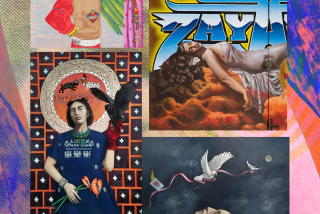‘Made in L.A.’ best in show: 5 must-see pieces at the Hammer biennial

The second iteration of the Hammer Museum’s “Made in L.A.” biennial has arrived, and it bears no evidence of a sophomore slump. There are funny ceramics, pervy paintings on bedsheets, abstract sculptures, installations about process, works saturated with politics, explorations of architecture and pieces on dance. Which means there is something for everybody.
The bonus: Every one of the exhibition’s 35 artists is given room to breathe, with large spaces that frequently showcase multiple works by a single person and allow for a bit of immersion. (Thank you, Hammer curators. I’m exhausted by exhibitions in which I feel like I’m being stuffed like a foie gras goose before slaughter.)
Even so, there’s still a whole lot of art to be reckoned with, including sculptures that evolve over the course of the show, a slew of performances, shows-within-a-show (a new favorite tic of biennials everywhere) and a working TV station that will produce all kinds of programming. Too much artsy fartsy? Well, I’ve come up with this cheeky little cheat sheet of the five pieces not to miss:
BEST IN SHOW: “Full Burn” by Mariah Garnett. If you can only see one piece out of this entire exhibition, head straight to Gallery 1 and take a seat for this riveting 20-minute video about former Navy SEALs and other servicemen talking about their new lives as Hollywood stuntmen — an occupation that requires them to set themselves on fire and jump off buildings. In a straightforward documentary style displayed on a pair of parallel screens, Garnett shows men discussing the challenging nature of their work in the military and in the movies.
Sometimes it can be difficult to know which line of work they are describing: “You’re not sure what is going to happen,” says one man. “But you are sure something is going to happen.” It’s especially poignant given the brisk resuscitation of the insurgency in Iraq over the past week. Who are the men we send to war? What have they seen and felt? And was it ultimately worth it? Questions you’ll be asking yourself long after the video is over.
BEST SHOW-WITHIN-A-SHOW: “Tony Greene: Amid Voluptuous Calm.” The show-within-a-show conceit can get irritating pretty fast, making a museum exhibition feel like an erratic art fair rather than a considered look at the art of an age. But this thoughtful tribute to the California artist who died of AIDS-related complications in 1990 at the tender age of 35 feels just right in this moment. Organized by David Frantz, curator at the ONE National Gay & Lesbian Archives here in L.A., the exhibition places Greene’s paintings — of vintage male pin-ups obscured by natural motifs and other patterns — among the work of his peers.
The exhibition takes us back to the gut-wrenching early days of the AIDS epidemic, when the waves of death among gay men were treated largely with institutional indifference. Doug Hammett’s curious log terrarium contains HIV-positive blood and Judie Bamber’s 1989 canvas of a goldfish out of water is acerbically titled “Oh Come on, It Doesn’t Hurt That Much.” A hair sculpture by Millie Wilson could be a drag queen’s out-of-scale wig or a stand-in for a body that is no longer with us.
The Whitney Biennial in New York also featured a show-within-a-show of work by Greene, but I’d argue that this exhibition is the better one, giving the artist’s luxuriant, somewhat inscrutable paintings a renewed sense of urgency — and setting up the vital political precedent to A.L. Steiner’s queer-politics-meets-environmentalism installation in the next gallery.
TRIPPIEST INSTALLATION: “Thank You” by Samara Golden. A room painted an acidic institutional green contains a similarly colored couch as well as racks of doll and dummy heads whose faces have been replaced by photographs of people Golden knows. The catch: All the pictures are 3-D and require special glasses for viewing. A strategically placed camera allows the viewer to see himself or herself in this funny-nightmarish fun house, which also contains various other 3-D touches.
There’s something earnest yet unsettling about the whole thing. Definitely a piece that makes you go, Duuuuude.
GOLD STAR FOR CRAFTINESS: Ceramics by Magdalena Suarez Frimkess and Michael Frimkess. A lot has been made in recent years about artists “returning” to craft after decades of working on industrial scales (think: Andy Warhol, Jeff Koons). The Frimkesses haven’t returned because, well, they never left. For roughly half a century, the pair have crafted wry ceramic pieces — he throws the pots, she paints them — that are often adorned with comic characters and other elements of contemporary life.
A Grecian-style urn contains images of the Chilean comic book character “Condorito” (about the high jinks of a working-class condor); another vessel references pre-Columbian imagery (Mesoamerican human sacrifice in “Eat Your Heart Out”). There are scenes from Latin American villages and sculptures that reference Mickey Mouse. One piece references Picasso’s famous war critique, “Guernica.”
Take time to admire the details, which offer plenty of small discoveries. And whatever you do, don’t miss the video that the Hammer made on this totally charming pair. Magdalena shows the comic books that inspire some of her paintings and Michael talks about how a peyote trip inspired him to take up clay in the first place.
SPECIAL CITATION FOR LABOR INTENSITY: The stop-motion animations of Tala Madani. A series of three small video screens in Gallery 5 contain a series of painted stop-motion animations by Madani, a painter who was born in Iran. In them, she takes the Everyman that appears in so many of her canvases (a bald, naked, sad sack usually involved in deplorable things) and animates him, one painting at a time. A single minute of animation requires 2,500 paintings. In these surreal pieces a man sprouts eyes that he then stabs out with scissors or murders every visitor who comes to his door.
I first saw Madani’s paintings in an exhibition at the New Museum and have been enthralled by them ever since: the abject adventures of this pudgy old man, the sort of figure that isn’t typical to a lot of contemporary art-making. To see them animated gives them a whole new layer of the grotesque, especially the drippy trails of paint that seem to follow him wherever he goes.
You can get a taste of what these animations feel like in this short video made by Frieze. But there’s nothing like being able to stand in the museum and watch these on an endless loop with their cartoonish levels of violence. It won’t be easy to look away.
More to Read
The biggest entertainment stories
Get our big stories about Hollywood, film, television, music, arts, culture and more right in your inbox as soon as they publish.
You may occasionally receive promotional content from the Los Angeles Times.







